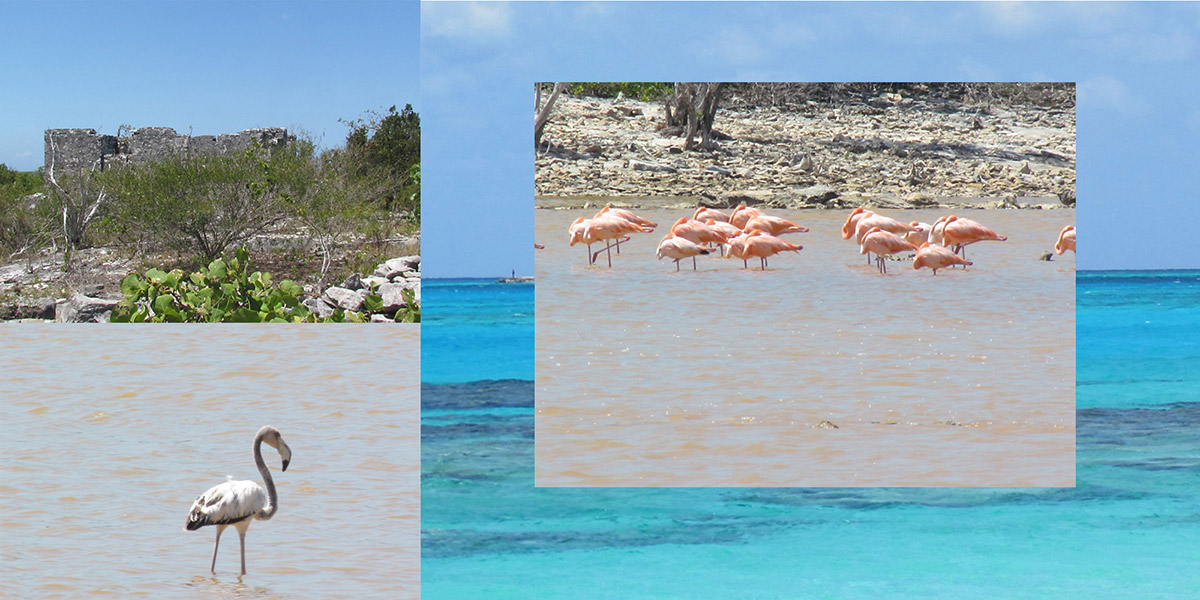
Sitting on a breezy, sandy thoroughfare from the east to the west of Long Cay, silence is only interrupted by a creaking door and rolling seas washing ashore on a pink sandy beach, where history has been washed out by time and bleached by the sun.
The scrub has stubbornly taken back much of the once-prominent southern Bahamian island, much like The Lost Footsteps Alejandro Carpentier so clearly illustrated as nature took back the land from development in the book of the same name. Nobel laureate, Gabriel García Márquez, commented on the same trend in his literary epic One Hundred Years of Solitude, where the inhabitants of Macondo fought against nature’s constant and unrelenting beat back on their homes and land.

Long Cay, part of the atoll of Crooked Island and Acklins, was famed to have been discovered by Christopher Columbus on 19th October, 1492, and—much like a sun-baked skeleton of bygone development—has a history of government misdirection and historical amnesia, working with time and nature to render it invisible to general Bahamian history.
Though it was an island pivotal in the development of The Bahamas’ early salt and maritime market, many writers dub these Bahama islands as places that time forgot; yet the inhabitants of these southern islands are all too aware of themselves and the plights and pitfalls of their history of development.
The government has, according to many, done a dirty in the development of the country, currying favour with some through removing favour from others. Political nepotism and election promises, it would be called now. The natural beauty of this long island is easily eclipsed by the difficulty of getting here.
In the early 1990s, I was fortunate enough to take a mailboat ride from Nassau to Mayaguana with stops in at Crooked Island just off Long Cay, Acklins, Inagua and then Mayaguana. The trip was a weeklong jaunt through the sunshine and rough January seas. Long Cay stood out as a place to come back to; it only took the better part of 20 years to get back.
After spending a week on Crooked Island in the late 1980s, (and again in the 1990s and early 2000s), the changes witnessed were stark. It seemed that entire communities had disappeared; houses stood in decay, trees were growing out of roofs and people were missing. Talking with locals, as we wait for the ferry from Cabbage Hill, Crooked to Long Cay, the breezes were cool and refreshing despite the sun’s beams through the cloudless sky. It was a surprise to see how much time had eaten away at the communities that had seemed small and old in the 80s but now seemed vastly lost.

From the days when old ladies said that they no longer told old stories because they were Christians and old stories were lies, to now, when there are so few old ladies around. After a few days of coaxing, some relented and served up indigenous culture with a wonderful accent of Bahamian Creole only found in these southern islands. Each one has its own ‘language’; each island is unique. The images of those days are fading, paper and negatives are hard to keep after decades of moving, but the mental images are etched into their DNA.
The stories were rich and opened windows into a history quickly being lost through silence and progress. Corseted, full-petticoated and be-hatted ladies dished out a rich spread of tales, punctuated by male voices offering insight from fishing, hog, and goat rearing and hunting. The shift from a major centre for drug drops in the height of the 1980s during the drug boom to the second decade in the 21st century is sobering.
So too is life now on Long Cay, formerly Fortune Island. There are no shops, restaurants, bars, or amenities, but there are goats and seemingly millions of flamingos. Mary, the snow-white goat, wanders the settlement Albert Town with two generations of offspring in tow, kids prancing and kicking their back legs.
From a community of 4,000 persons including 200 students in the local school, to a school of two pupils and one teacher, Long Cay has come a long way from being the gateway north from south and the home to many pilots, who would steer steamships up through the country’s beauty-laden but treacherous seas and oceans.
Albert Town is the only living community as Douglas Town, formerly the thriving upper and middle-class settlement, according to stories, stands in ruins covered over by brush and scrub; the middle of the island offers salt from Great Salt Pond. What happened to the colour-divided settlement that provided salt and cotton to drive national and personal development? Long time Long Cay resident, Mr. Bruce, shared story upon story of T.O. Williams and his antics. While a voice for old Long Cay, Mr. Bruce was also a voice of travelling experiences through the southern United States during Jim Crow. As a young man, he said he got upset with his father and took off, and there begin the stories that would pepper his music.
A man of passion and exuberance, Mr. Bruce was eager to share with folks. He, like many of the older residents who have lived full lives abroad and returned ‘home’ to redevelop and to live a peaceful life, share their adventures and missteps warmly and happily. Their stories coat the outside crumbling walls with a layer of life that is otherwise missing from the experience.